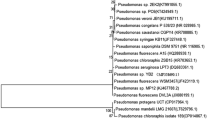Abstract
Purpose
Malachite Green (MG) is used for a variety of applications but is also known to be carcinogenic and mutagenic. In this study, a novel Micrococcus sp. (strain BD15) was observed to efficiently decolorize MG. The purposes of this study were to explore the optimal conditions for decolorization and to evaluate the potential use of this strain for MG decolorization.
Methods
Optical microscope and UV–visible analyses were carried out to determine whether the decolorization was due to biosorption or biodegradation. A Plackett–Burman design was employed to investigate the effect of various parameters on decolorization, and response surface methodology was then used to explore the optimal decolorization conditions. Kinetics analysis and antimicrobial activity tests were also performed.
Results
The results indicated that the decolorization by the strain was mainly due to biodegradation. Concentrations of MG, urea, and yeast extract and inoculum size had significantly positive effects on MG decolorization, while concentrations of CuCl2 and MgCl2, and temperature had significantly negative effects. The interaction between different parameters could significantly affect decolorization, and the optimal conditions for decolorization were 1.0 g/L urea, 0.9 g/L yeast extract, 100 mg/L MG, 0.1 g/L inoculums (dry weight), and incubation at 25.2°C. Under the optimal conditions, 96.9% of MG was removed by the strain within 1 h, which represents highly efficient microbial decolorization. Moreover, the kinetic data for decolorization fit a second-order model well, and the strain showed a good MG detoxification capability.
Conclusion
Based on the results of this study, we propose Micrococcus sp. strain BD15 as an excellent candidate strain for MG removal from wastewater.






Similar content being viewed by others
References
Ayed L, Chaieb K, Cheref A, Bakhrouf A (2009) Biodegradation of triphenylmethane dye Malachite Green by Sphingomonas paucimobilis. World J Microbiol Biotechnol 25:705–711
Ayed L, Khelifi E, Jannet HB, Miladi H, Cheref A, Achour S, Bakhrouf A (2010a) Response surface methodology for decolorization of azo dye Methyl Orange by bacterial consortium: produced enzymes and metabolites characterization. Chem Eng J 165:200–208
Ayed L, Chaieb K, Cheref A, Bakhrouf A (2010b) Biodegradation and decolorization of triphenylmethane dyes by Staphylococcus epidermidis. Desalination 260:137–146
Chen CH, Chang CF, Liu SM (2010a) Partial degradation mechanisms of malachite green and methyl violet B by Shewanella decolorationis NTOU1 under anaerobic conditions. J Hazard Mater 177:281–289
Chen XJ, Jin DF, Ding HT, Lin H, Zhao YH (2010b) Isolation and characterization of decabromodiphenyl ether (BDE-209)-degrading bacteria. J Zhejiang Univ-Agric Life Sci 36:521–527
Daneshvar N, Khataee AR, Rasoulifard MH, Pourhassan M (2007) Biodegradation of dye solution containing Malachite Green: Optimization of effective parameters using Taguchi method. J Hazard Mater 143:214–219
Das D, Charumathi D, Das N (2010) Combined effects of sugarcane bagasse extract and synthetic dyes on the growth and bioaccumulation properties of Pichia fermentans MTCC 189. J Hazard Mater 183:497–505
Deng DY, Guo J, Zeng GQ, Sun GP (2008) Decolorization of anthraquinone, triphenylmethane and azo dyes by a new isolated Bacillus cereus strain DC11. Int Biodeter Biodegr 62:263–269
Du LN, Wang S, Li G, Wang B, Jia XM, Zhao YH, Chen YL (2011) Biodegradation of malachite green by Pseudomonas sp. strain DY1 under aerobic condition: characteristics, degradation products, enzyme analysis and phytotoxicity. Ecotoxicology 20:438–446
El-Sayed WS, El-Baz AF, Othman AM (2006) Biodegradation of melamine formaldehyde by Micrococcus sp. strain MF-1 isolated from aminoplastic wastewater effluent. Int Biodeter Biodegr 57:75–81
Jadhav JP, Govindwar SP (2006) Biotransformation of malachite green by Saccharomyces cerevisiae MTCC 463. Yeast 23:315–323
Levin L, Forchiassin F, Viale A (2005) Ligninolytic enzyme production and dye decolorization by Trametes trogii: application of the Plackett-Burman experimental design to evaluate nutritional requirements. Process Biochem 40:1381–1387
Li LT, Hong Q, Yan X, Fang GH, Ali SW, Li SP (2009) Isolation of a malachite green-degrading Pseudomonas sp. MDB-1 strain and cloning of the tmr2 gene. Biodegradation 20:769–776
Lin XY, Xu XH, Yang CH, Zhao YH, Feng ZH, Dong YY (2009) Activities of antioxidant enzymes in three bacteria exposed to bensulfuron-methyl. Ecotox Environ Safe 72:1899–1904
Lyubenova L, Nehnevajova E, Herzig R, Schröder P (2009) Response of antioxidant enzymes in Nicotiana tabacum clones during phytoextraction of heavy metals. Environ Sci Pollut Res 16:573–581
Mulla SI, Hoskeri RS, Shouche YS, Ninnekar HZ (2011) Biodegradation of 2-nitrotoluene by Micrococcus sp. strain SMN-1. Biodegradation 22:95–102
Saratale RG, Saratale GD, Chang JS, Govindwar SP (2009) Ecofriendly degradation of sulfonated diazo dye C.I. Reactive Green 19A using Micrococcus glutamicus NCIM-2168. Bioresource Technol 100:3897–3905
Shedbalkar U, Jadhav JP (2011) Detoxification of Malachite Green and textile industrial effluent by Penicillium ochrochloron. Biotechnol Bioproc E 16:196–204
Singh SS, Dikshit AK (2010) Optimization of the parameters for decolourization by Aspergillus niger of anaerobically digested distillery spentwash pretreated with polyaluminium chloride. J Hazard Mater 176:864–869
Srivastava S, Sinha R, Roy D (2004) Toxicological effects of malachite green. Aqua Toxicol 66:319–329
Zheng CL, Qu BC, Wang J, Zhou JT, Wang J, Lu H (2009) Isolation and characterization of a novel nitrobenzene-degrading bacterium with high salinity tolerance: Micrococcus luteus. J Hazard Mater 165:1152–1158
Acknowledgments
This study was supported by the National Natural Science Foundation of China (31070079), the Science and Technology Project of Zhejiang Province (2008C13014-3, 2010C13G2010074), and the International Cooperation Project in Science and Technology of Zhejiang Province (no. 2008C14038).
Author information
Authors and Affiliations
Corresponding author
Additional information
Responsible editor Hailong Wang
Electronic supplementary material
Below is the link to the electronic supplementary material.
ESM 1
(DOC 13494 kb)
Rights and permissions
About this article
Cite this article
Du, LN., Zhao, M., Li, G. et al. Highly efficient decolorization of Malachite Green by a novel Micrococcus sp. strain BD15. Environ Sci Pollut Res 19, 2898–2907 (2012). https://doi.org/10.1007/s11356-012-0796-1
Received:
Accepted:
Published:
Issue Date:
DOI: https://doi.org/10.1007/s11356-012-0796-1




